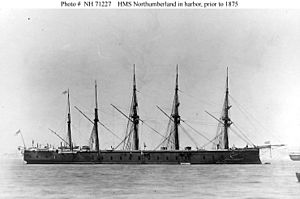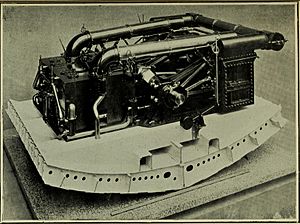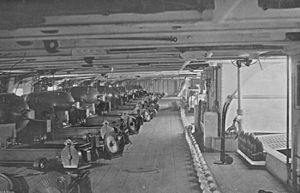HMS Northumberland (1866) facts for kids

Northumberland in her original 5-masted configuration
|
|
Quick facts for kids History |
|
|---|---|
| Name | HMS Northumberland |
| Namesake | Northumberland |
| Ordered | 2 September 1861 |
| Builder | Millwall Iron Works, Millwall, London |
| Cost | £444,256 |
| Laid down | 10 October 1861 |
| Launched | 17 April 1866 |
| Completed | 8 October 1868 |
| Commissioned | October 1868 |
| Decommissioned | 1898 |
| Out of service | Hulked, 1909 |
| Renamed |
|
| Reclassified | Training ship, 1898 |
| Stricken | 1927 |
| Fate |
|
| General characteristics (as completed) | |
| Class and type | Minotaur-class armoured frigate |
| Displacement | 10,584 long tons (10,754 t) |
| Length | 400 ft 4 in (122.0 m) p/p |
| Beam | 59 ft 5 in (18.1 m) |
| Draught | 27 ft 9 in (8.5 m) |
| Installed power |
|
| Propulsion | 1 shaft, 1 Trunk steam engine |
| Sail plan | 5-masted |
| Speed | 14 knots (26 km/h; 16 mph) |
| Range | 2,825 nmi (5,232 km; 3,251 mi) at 10 knots (19 km/h; 12 mph) |
| Complement | 800 |
| Armament | |
| Armour |
|
HMS Northumberland was a large warship built for the Royal Navy in the 1860s. She was the last of three ships in her class, known as the Minotaur-class armoured frigates. These ships were special because they had strong iron armor to protect them.
Northumberland was a bit different from her sister ships. She had a unique armor design and carried bigger guns. Because of these differences, some people called her a "half-sister." She spent most of her active time with the Channel Squadron, a group of ships that patrolled the English Channel. Sometimes, she even served as a flagship, which means she was the main ship for an admiral.
Later in her life, Northumberland was put into reserve in 1890. This means she was kept ready but not actively used. In 1898, she became a training ship, helping to teach new sailors. By 1909, she was turned into a coal hulk, which is basically a floating storage unit for coal. She was sold in 1927 and finally taken apart for scrap metal in 1935.
Contents
Building a Giant: The Northumberland Design
The Minotaur-class armored frigates were like bigger, stronger versions of an earlier ship called HMS Achilles. They were designed with more powerful engines, thicker armor, and heavier weapons. These ships kept the traditional "broadside" design, meaning their guns were placed along the sides of the ship.
Their entire sides were covered in armor to protect the many guns they were meant to carry. They also had a noticeable ram at the front, shaped like a plow. This ram was designed to smash into enemy ships.
Northumberland was very long, about 400 feet 4 inches (122.0 m) from end to end. She was 58 feet 5 inches (17.8 m) wide and sat 27 feet 9 inches (8.5 m) deep in the water. The ship weighed about 10,584 long tons (10,754 t). Her hull, or body, was divided into 15 waterproof sections by bulkheads. She also had a double bottom under her engine and boiler rooms for extra safety. Sailors thought she was a good ship to fire guns from and easy to steer. She was designed for a crew of 705, but often carried 800 people.
How Northumberland Moved: Engines and Sails
Northumberland used a special two-cylinder steam engine built by John Penn and Sons. This engine powered a single propeller. Steam for the engine came from 10 large, rectangular fire-tube boilers. During her sea trials in 1868, the engine produced 6,558 indicated horsepower (4,890 kW) of power. This allowed Northumberland to reach a top speed of 14.1 knots (26.1 km/h; 16.2 mph).
The ship usually carried 750 long tons (760 t) of coal to fuel her engines. She could carry up to 1,400 long tons (1,400 t) of coal, which was enough to travel 2,825 nautical miles (5,232 km; 3,251 mi) at a speed of 10 knots (19 km/h; 12 mph).
Even though she had a powerful engine, Northumberland also had sails. She was first designed with five masts. However, during a major repair from 1875 to 1879, two masts were removed. She was then re-rigged as a barque, a type of sailing ship with fewer masts.
Under sail alone, Northumberland was quite slow, only reaching 7 knots (13 km/h; 8.1 mph). This was because her propeller could not be lifted out of the water to reduce drag. It was considered the slowest sailing speed of any ironclad of her time. One admiral, George A. Ballard, even said that the Minotaur-class ships were "the dullest performers under canvas." This meant they were not good at sailing, even with all their sails.
What Guns Did Northumberland Carry?
Unlike her sister ships, Northumberland had a mix of different sized guns. She carried seven-inch (178 mm), eight-inch (203 mm), and nine-inch (229 mm) rifled muzzle-loading guns.
- Four nine-inch (229 mm) guns and 18 eight-inch (203 mm) guns were placed on the main deck.
- Four more eight-inch (203 mm) guns were on the upper deck, used as chase guns (guns that could fire forward or backward).
- Two seven-inch (178 mm) guns were at the back of the main deck, also as chase guns.
These guns were very powerful for their time. The nine-inch gun could shoot through 11.3 inches (287 mm) of wrought iron armor. The eight-inch gun could penetrate 9.6-inch (244 mm) of armor, and the seven-inch gun could go through 7.7 inches (196 mm).
In 1875, Northumberland was updated with new weapons. She then had seven nine-inch guns and two eight-inch guns at the back. Later, in 1886, she received two six inches (152 mm) breech-loading guns. Even more guns were added later, including six quick-firing (QF) four point seven inches (119 mm) guns, 10 small three pounder[convert: unknown unit] Hotchkiss guns, and six machine guns.
How Was Northumberland Protected?
Northumberland had strong iron armor to protect her. Unlike her sister ships, her entire side was not covered. Instead, her main gun area, called the battery, was heavily protected above the main deck.
She had a complete waterline armor belt around her middle. This belt was 4.5 inches (114 mm) thick at the ends and 5.5 inches (140 mm) thick in the middle. It went 5 feet 9 inches (1.8 m) below the water. The sides of the battery were 184.5 feet (56.2 m) long and protected by 5.5 inches (140 mm) thick armor on all sides, including the walls in front and behind the guns.
The two forward chase guns on the upper deck also had armored walls for protection. However, the chase guns at the back of that same deck were not protected by armor. The armor plates were backed by 10 inches (254 mm) of strong teak wood. The ship also had a conning tower, a protected area for the commander, which had 4.5 inches (114 mm) thick armor plates.
Building and Serving: Northumberland's History
Northumberland was named after the ceremonial county in England. Her construction began on October 10, 1861, at the Millwall Ironworks in London. Her design was changed while she was being built, after a new Chief Constructor, Sir Edward Reed, took over.
The ship stayed on the building slip for five years before she was ready to be launched. This long delay was partly because her design kept changing. When it was time to launch her on April 17, 1866, she got stuck! She only slid halfway down the slipway, with her back end hanging in the air. This was dangerous and could have damaged the ship.
Even with hydraulic jacks and tugboats, they couldn't get her into the water during the next high tide. Finally, using special pontoons, they successfully launched her. However, her builders went bankrupt during the launch. The company's liquidators (people who handle a bankrupt company's assets) took Northumberland as their property. It took eight months for the Admiralty (the Royal Navy's leadership) to get the ship back and start finishing her. She was officially ready for duty in October 1868, costing a total of £444,256.
Northumberland's first assignment was with the Channel Squadron, where she stayed until 1873. Her first captain, Roderick Dew, had her yards (parts of the mast that hold sails) painted black. This way, people could easily tell her apart from her sister ships, whose yards were white.
During this time, she helped her sister ship Agincourt tow a huge floating drydock from England to Madeira. A drydock is like a floating garage for ships. From Madeira, other ships, Warrior and Black Prince, took the drydock to Bermuda. The ships left England on June 23, 1869, carrying 500 long tons (510 t) of coal in bags on their gun decks. They transferred the drydock 11 days later after a smooth journey.
On Christmas Day in 1872, while anchored at Funchal, Madeira, a storm hit. Northumberland's anchor chain broke, and she drifted into the ram bow of another ironclad, Hercules. Northumberland was badly damaged below the waterline, and one section of the ship filled with water. Luckily, she was still able to steam to Malta for repairs.
From 1873 to 1875, while her sister ship Minotaur was being repaired, Northumberland served as the flagship for the second-in-command of the Channel Squadron. She was the main ship for Rear Admirals George Hancock and Lord John Hay.
Northumberland herself underwent major repairs and had her weapons updated from 1875 to 1879. After this, she rejoined the Channel Squadron. In 1885, she was taken out of service for another refit. When she was finished in 1887, she became the flagship for Vice Admirals Sir William Hewett and John Baird, who were commanders of the Channel Squadron.
In 1890, Northumberland was assigned to the 1st Reserve Squadron, first at the Isle of Portland and then at Devonport until 1898. In 1898, she was turned into a hulk and used as a stokers' (engine room crew) training ship at the Nore. On January 1, 1904, she was renamed Acheron.
From 1909 to 1927, the ship served as a coal hulk at Invergordon, storing coal. She was renamed C.8 in 1909 and then C.68 in 1926. The ship was sold in 1927. However, she was then resold and renamed Stedmound. She continued to serve at Dakar until she was finally taken apart for scrap metal in 1935.
Relics
You can see two large, half-scale models of Northumberland from the 1870s at the Museum of London Docklands.





